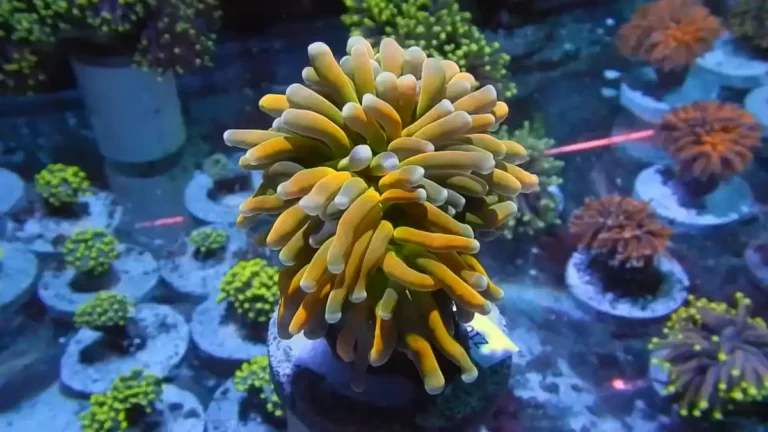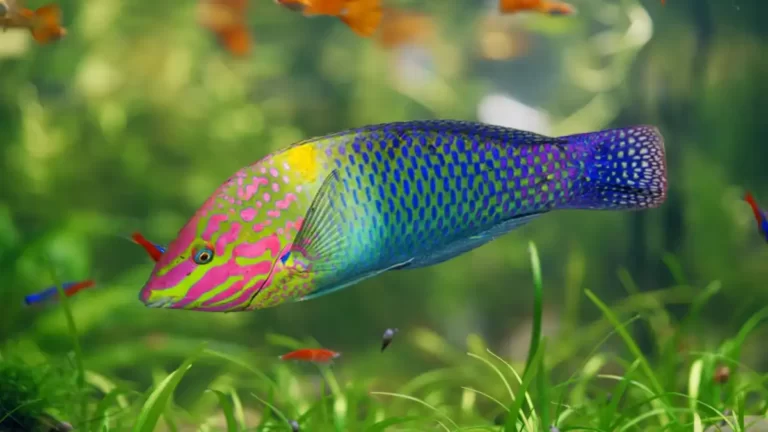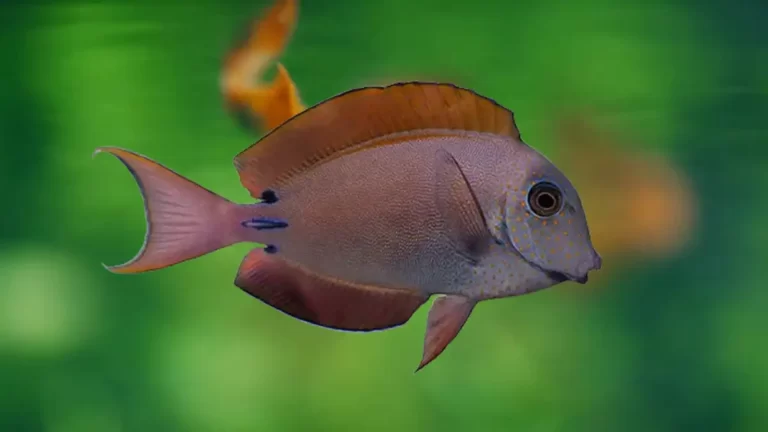Gold Rim Tang Care: Essential Care and Tank Requirements
Discover the captivating world of Gold Rim Tangs, a stunning addition to any aquarium. Known for their vibrant colors and distinctive golden accents, these fish offer a mesmerizing sight. Proper care is essential to ensure their health and vibrancy.
From tank setup and water parameters to dietary needs and social behavior, this guide provides expert insights for both novice and experienced aquarists. Dive into the details of Gold Rim Tang care and create a thriving aquatic environment that showcases the beauty of these remarkable marine creatures.
Gold Rim Tang-Quick Facts:
| Property | Information |
| Scientific Name | Acanthurus nigricans |
| Family | Acanthuridae |
| Origin | Indo-Pacific region |
| Size | Up to 10-12 inches (25-30 cm) |
| Diet | Herbivorous |
| Tank Size | 125 gallons |
| Tank Conditions | Tropical marine, stable water parameters |
| Temperament | Generally peaceful, may show aggression towards similar species |
| Lifespan | Around 10-15 years |
| Coloration | Black, Purple, Yellow |
| Care Difficulty | Moderate |
| Water Conditions | sg 1.020-1.025, 72-78° F, dKH 8-12, pH 8.1-8.4 |
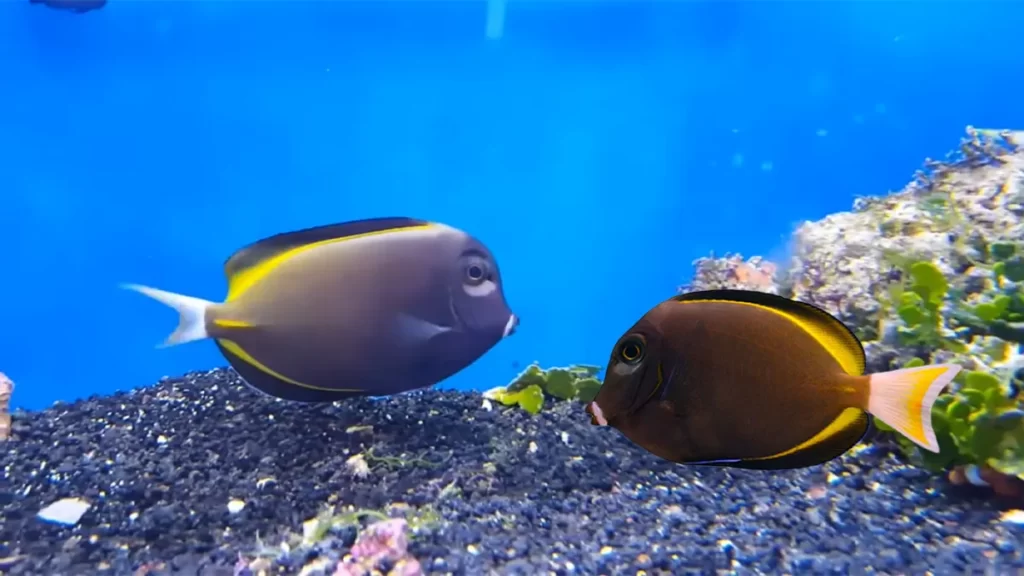
Species Summary
The Gold Rim Tang, also known as Whitecheek Surgeonfish or Acanthurus nigricans, is a beautiful and active marine fish. They can be a wonderful addition to a reef aquarium due to their voracious appetite for algae, helping to keep the tank clean 1. They are found primarily in the Central Pacific region and are considered an expert level fish to care for.
Gold Rim Tang Appearance
Gold Rim Tangs are characterized by their unique color patterns, featuring a combination of yellow, grey, blue, white, black, and brown shades. Their most distinguishing feature is the gold-rimmed edges on their fins, giving them their name. They also have prominent white cheeks, which contrast with their dark gray to black bodies2.
Lifespan
The lifespan of a Gold Rim Tang can be influenced by factors such as diet, water quality, and tank conditions. With proper care, they can live for several years in a well-maintained aquarium3.
Average Size
A fully grown Gold Rim Tang can reach an average size of about 8 inches in length. This makes them a sizable addition to a marine aquarium, and they should be housed in a tank with a minimum capacity of 125-gallons to provide them with enough space to swim and hide. Due to their aggressive nature, it is recommended to keep them separate from other tangs or similar-shaped fishes.
Gold Rim Tang Care
Tank Size
The Gold Rim Tang requires an adequate amount of space to thrive. A tank size of at least 125-gallons is recommended to provide the fish with ample swimming space and to reduce stress.
Water Parameters
It is essential to maintain stable water parameters for the Gold Rim Tang. Optimal water parameters include:
- Temperature: 72-78°F (22-25°C)
- pH: 8.1-8.4
- Salinity: 1.023-1.025 sg
- Ammonia, nitrite, and nitrate levels should be close to zero.
Frequent water changes and proper filtration systems are necessary to ensure these parameters remain consistent.
Tank Setup
A well-thought-out tank setup plays a vital role in the health of the Gold Rim Tang. Here are some key aspects to consider:
- Live Rock and Hiding Spots: Providing plenty of live rock and hiding spots encourages natural grazing behavior and reduces stress.
- Substrate: A fine sand substrate is recommended, as it imitates the fish’s natural habitat.
- Lighting: Moderate to strong lighting promotes the growth of algae, which the Gold Rim Tang feeds on.
- Tank Mates: Be cautious when selecting tank mates since the Gold Rim Tang can be aggressive towards other tangs or similarly shaped fish. Suitable tank mates include peaceful community fish and invertebrates.
- Diet: Offer a varied diet to maintain the Gold Rim Tang’s health, including both vegetable and meaty foods. Additionally, provide Nori or dried seaweed sheets to satisfy their grazing urge.
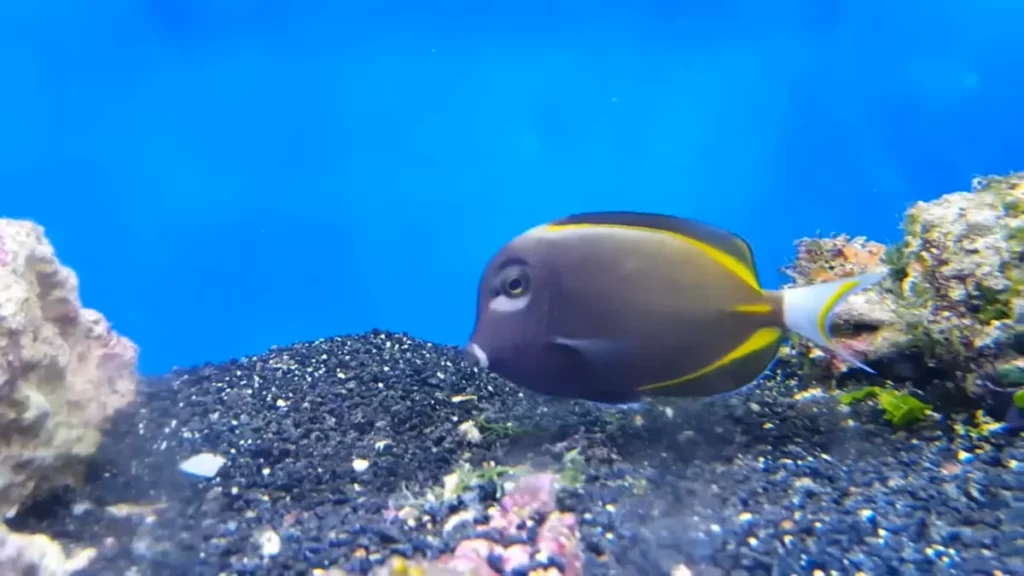
Read More: Can Expired Fish Food Kill Fish [Explain]
Are Gold Rim Tang Reef Safe?
Gold Rim Tangs, scientifically known as Acanthurus nigricans, are popular marine fish species that many aquarium enthusiasts consider adding to their reef tank. One common question is whether these tangs are safe for reef environments.
The answer is yes, Gold Rim Tangs can be kept in both fish-only and reef environments. This is because they are generally peaceful and non-aggressive, making them suitable tankmates for a wide range of marine species. Additionally, they are not known to cause harm to corals or other invertebrates typically found in a reef tank setup.
However, it is important to note that the aquarium should be well-established and at least six months old before adding a Gold Rim Tang. This ensures that the water parameters are stable and there is ample natural algae growth to support the dietary needs of this herbivorous fish. This can be achieved by providing plenty of live rock and ensuring proper water quality through regular monitoring and maintenance.
Another aspect to consider in maintaining a healthy environment for Gold Rim Tangs is the tank size and available swimming space. These fish can grow relatively large and active, so providing them with ample space to swim without encountering conflicts with other tank inhabitants is essential for their well-being.
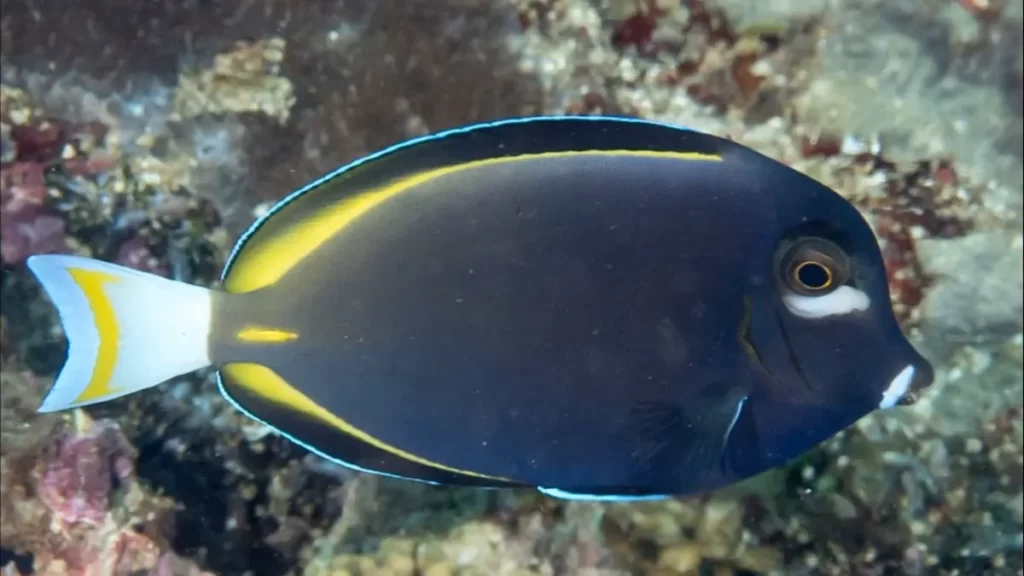
Food & Diet
One of the key factors in preventing diseases in gold rim tangs is providing a proper and balanced diet. Tangs are susceptible to nutritional deficiency syndromes, such as Head and Lateral Line Erosion Disease (HLLE). To avoid HLLE and other nutritional issues, it’s essential to provide tangs with a balanced diet that includes a mixture of high-quality marine pellets, frozen foods, and fresh vegetables.
- Feed them 2-3 times a day in small amounts
- Variety of foods is crucial: algae, spirulina, mysis shrimp, and chopped seafood
- Supplement their diet with vitamin and mineral enriched food products
Maintaining good water quality can also help prevent diseases by eliminating stress and maintaining a healthier environment for the fish.
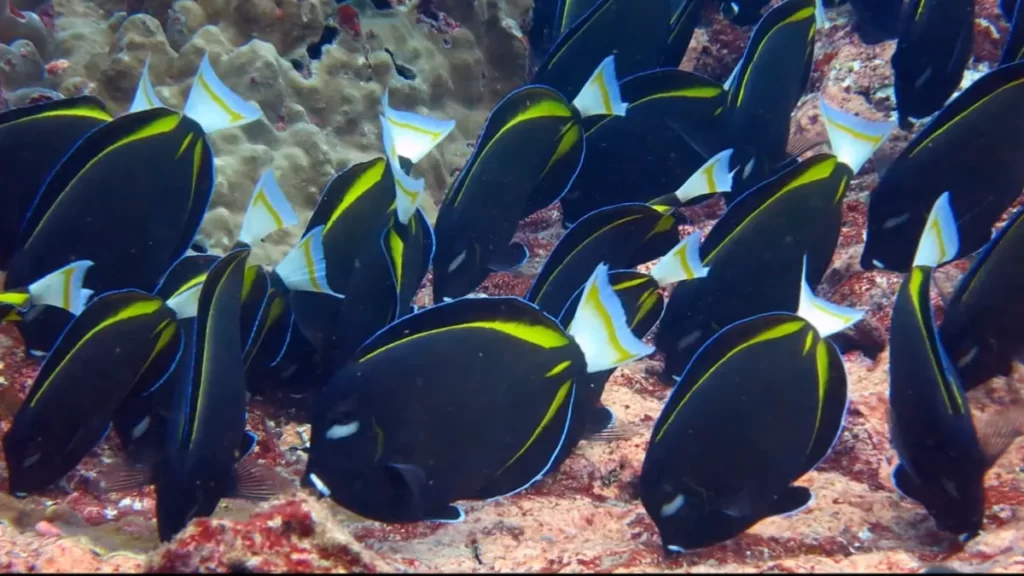
Behavior & Temperament
Gold rim tangs are relatively peaceful fish, but they may become aggressive towards other tangs or similar-shaped fish. Stress caused by territorial disputes and aggression can lead to a weakened immune system, making fish more susceptible to diseases. Monitoring their behavior and providing a habitat that allows for territory establishment can prevent health issues.
- Ensure your aquarium is large enough for multiple tangs (at least 75 gallons) to provide adequate space
- Place live rock and decorations to create hiding spots and territory boundaries
- Observe your fish daily to watch for signs of aggression or stress
By ensuring proper food, diet, and adequate habitat, gold rim tang owners can minimize the risk of diseases and enjoy a healthy, vibrant aquarium.
Gold Rim Tang Tank Mates & Predators
The Gold Rim Tang, also known as the Whitecheek Surgeonfish or Powder Gray Surgeonfish, is a popular saltwater fish for aquarium enthusiasts. However, this tang species can be aggressive and territorial, making it essential to choose appropriate tank mates for maintaining harmony within the tank.
One option for tank mates is pairing the Gold Rim Tang with fish species that are not in the Tang or Surgeonfish families, such as Clownfish, Damselfish, and others that can tolerate the tang’s aggression. Creating a community that consists of a variety of fish species and sizes can help distribute the aggression and reduce conflicts within the tank.
Another aspect to consider is adding Gold Rim Tangs to a well-established tank that has been running for at least 6 months. This allows for stable water parameters and ample natural algae growth, which contributes to a balanced and comfortable environment for the fish.
When it comes to predators of the Gold Rim Tang, it is crucial to avoid housing them with larger, more aggressive species such as Lionfish, Groupers, or Eels. These species may prey on tangs and other smaller fish in the tank. To ensure the safety and well-being of the Gold Rim Tang, make sure the tank is free of predatory species.
Using live rock to create hiding spots and territorial boundaries within the tank can also help reduce conflicts and stress among the community. This can be especially helpful when adding new tank mates and promoting a harmonious environment for the Gold Rim Tang and its tank companions.
Breeding
The Gold Rim Tang, scientifically known as Acanthurus nigricans, is a species that can interbreed with other Tang varieties, resulting in unique hybrids. When the Gold Rim Tang breeds with the Powder Blue Tang, the hybrid fish mostly inherits the traits from the Powder Blue, particularly in terms of appearance . On the other hand, when it mates with the Achilles Tang, the Gold Rim’s genes tend to dominate the hybrid offspring .
While breeding Gold Rim Tangs in captivity is not a common practice, they are usually collected in the wild for the aquarium trade. Their natural habitat includes the tropical and subtropical waters of the central Pacific Ocean, where they can be found in coral reefs and rocky areas . These fish can grow up to 8.5 inches in length and thrive in water with a pH range of 8.1-8.4, salinity of 1.020-1.025, and temperatures ranging from 72-78°F .
Providing the appropriate water conditions, diet, and tank setup is crucial to ensure the health of Gold Rim Tangs in an aquarium. Although their breeding habits aren’t well-known in captivity, it is important to be aware of their compatibility with other fish types. Being one of the most aggressive surgeonfish, it is better to keep Gold Rim Tangs separate from similar fish, such as surgeons or other tangs . By maintaining a stress-free environment, the chances of successful breeding may be higher.
Related Post: Biota Yellow Tang Care: Diet, Lifespan, Mates and Venom
Frequently Asked Questions [FAQs]
What is the lifespan of a Gold Rim Tang?
The lifespan of a Gold Rim Tang can vary depending on factors such as diet, water quality, and overall tank environment. However, with proper care and suitable living conditions, these fish can live up to several years.
Which tank mates are suitable for Gold Rim Tang?
Gold Rim Tangs are known to be aggressive towards similar-shaped fish, such as other surgeonfish and tangs. It is recommended to not keep them with similar species in the same tank to avoid conflicts. They can coexist with other compatible tank mates like clownfish, blennies, and cardinalfish, which have different body shapes and avoid confrontation with Gold Rim Tangs.
What are the differences between Gold Rim Tang and Powder Brown Tang?
While Gold Rim Tang and Powder Brown Tang may appear visually similar, there are some key differences in their size, behavior, and origin. Gold Rim Tang, also known as the Whitecheek Surgeonfish, has a black to purplish-blue body and a small white mark on the cheek . The Powder Brown Tang has a more brownish color, without the white cheek mark. The species are distinguished by their different scientific names, with Gold Rim Tang being Acanthurus nigricans and Powder Brown Tang being Acanthurus japonicus. Gold Rim Tangs are more aggressive compared to Powder Brown Tangs and their growth rate and size may also vary.
How big do Gold Rim Tangs grow?
Gold Rim Tangs are relatively smaller than some other tang species. They can reach a size of about 8 1/3 inches (21.3 cm) in length. To properly house a Gold Rim Tang, it is advisable to have a tank of at least 55 gallons, with ample hiding spots, live rocks, and proper filtration to maintain water quality for their growth and well-being.
Related Posts:


